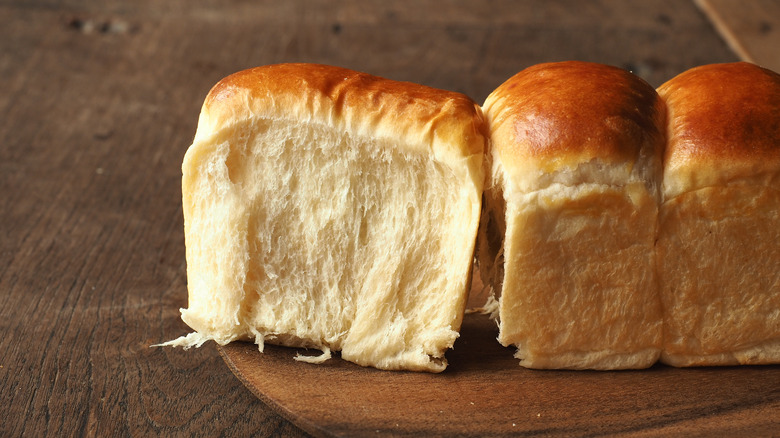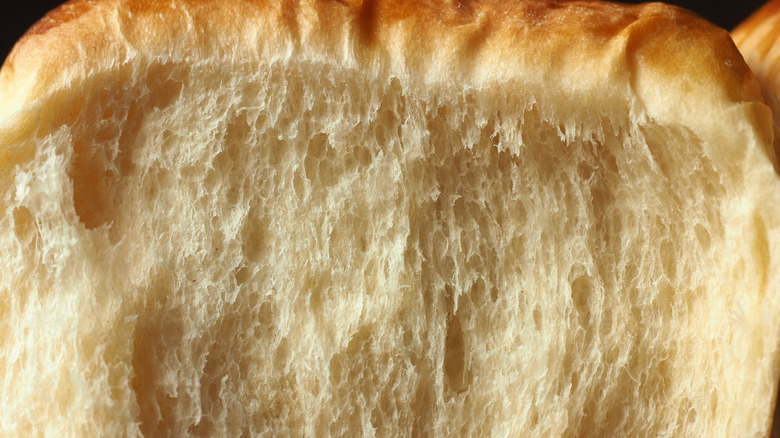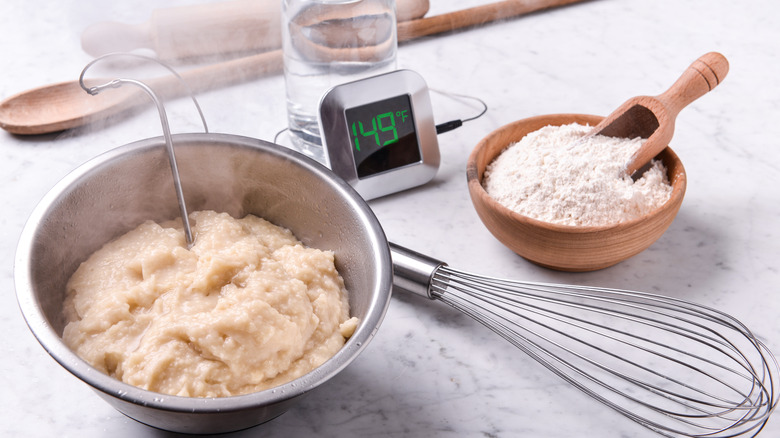Tangzhong Is The Key Method For Achieving Ultra Tender Bread
Baking bread is one of the most satisfying things a home cook can do, but the results are tragically ephemeral. You could spend the bulk of a day kneading until your arms ache, then wait through agonizingly slow hours of rising time, only to have your finished loaf turn stale by the next morning. Most supermarket bread avoid this with an array of preservatives and dough conditioners, which is not the most appealing solution, if we're being honest. Fortunately, there is a much simpler way to extend your homemade bread's shelf life, using a method popular in East Asian baking called tangzhong.
Tangzhong is a Mandarin term referring to a mixture of flour and liquid (typically water, milk, or a combination of both) cooked over low heat to form a thick paste and then incorporated into bread dough. It is similar to a roux, except it replaces the fat with water or milk. In fact, it is sometimes known in English as a water roux. Tangzhong was popularized by Taiwanese baker Yvonne Chen through her 2005 book "65°C Bread Doctor" and is closely related to a Japanese technique called Yudane, which is essentially the same, except that it involves pouring hot water into flour instead of cooking the two together. This is a key component of Japanese milk bread, renowned for its pillowy texture that lasts for days without hardening, but you can adapt it to all kinds of bread recipes to keep them fresh and fluffy.
What tangzhong does for bread
To understand how tangzhong preserves the texture of bread, you need to understand why bread goes stale in the first place. The starch molecules in raw wheat flour are arranged in a rigid, crystalline structure, but when you add water to the flour and expose it to heat, that structure comes apart. This process is called starch gelatinization, and it's the reason that freshly-baked bread is so soft. However, as the bread gradually cools, the moisture within it evaporates and the starch molecules return to their firm, crystalline state in a process called retrogradation.
Making bread with tangzhong greatly slows the retrogradation process because cooking some of the flour and liquid together before adding it to the dough pre-gelatinizes the starch. Flour is able to absorb a much greater volume of liquid when that liquid is hot. By making a tangzhong, you can incorporate more liquid into your bread, and consequently, it will take longer for that moisture to be lost, delaying the time it takes for your bread to go stale.
Tangzhong sometimes gets credit for the airy, melt-in-your mouth texture of Japanese milk bread, but that actually has more to do with the fat and sugar in these recipes. While crusty European breads are typically made with just flour, water, and yeast, many East Asian breads add butter and sugar. These contribute more to the bread's initial texture than tangzhong, and tangzhong's real role is in preserving that texture.
How to make and use tangzhong
The best thing about tangzhong is that you can adapt it to almost any bread recipe. That said, not all types of bread benefit from tangzhong. Crispy and chewy bread like sourdough, baguettes, and bagels are not meant to be pillowy, so the technique is not in keeping with their nature. Tangzhong should be used with soft, enriched bread. Enriched bread contains fatty ingredients such as butter, oil, milk, or eggs. Milk bread, sandwich bread, dinner rolls, and even sweet cinnamon buns are perfect for the tangzhong method.
To make tangzhong, pick a bread recipe and make note of its hydration level. Hydration is the percent of liquid compared to flour, so a recipe that calls for 100 grams of flour and 70 grams of water has a 70% hydration level (note: hydration must be measured by weight, not volume, so if your recipe has measurements by the cup, you should weigh each proportion before calculating the hydration level). To use a tangzhong, you want the bread to have about 75% hydration, so you may need to add extra liquid to your recipe to reach that level. Place 5-10% of the flour in a pot and add five parts liquid to each part flour. Cook this mixture over low heat until it reaches the consistency of paste, which happens around 149 degrees Fahrenheit. Let the tangzhong cool to room temperature, then add it to your dough and proceed with your recipe.


